Report

The New Luxury Consumer: Why Responding to the Millennial Mindset Will Be Key
Luxury is back in fashion
The 16th edition of the Bain Luxury Study, published by Bain & Company for Fondazione Altagamma, the trade association of Italian luxury goods manufacturers, analyzed recent developments in the global luxury goods industry.
The overall luxury industry tracked by Bain comprises nine segments, led by luxury cars, luxury hospitality and personal luxury goods, which together account for more than 80% of the total market.
Considering all segments, the luxury market grew by 5% to an estimated €1.2 trillion globally in 2017. Sales of luxury cars continued to dominate the market, increasing by 6% to reach €489 billion in total. Luxury experiences remained very attractive to consumers, as illustrated by sales growth of high-end food and wine (both up 6% from last year), and sales of luxury cruises (up an impressive 14%).
The market for personal luxury goods—the "core of the core" and the focus of this analysis—reached a record high of €262 billion, boosted by a revival of purchasing by Chinese customers both at home and abroad, as well as strong trends within other customer groups and in other regions. That represented 5% growth at current exchange rates, and 6% at constant exchange rates.
Personal luxury goods rebound, driven by sustained growth in key regions
Worldwide, the personal luxury goods market experienced growth across all regions, driven both by more robust local consumption (up 4%) and by strong tourist purchases (up 6%).
China was a clear top performer. Chinese consumption bounced back in 2017, fueled by renewed consumer confidence and the rapid emergence of a new—and increasingly fashion-savvy—middle class. Local buying by Chinese customers boosted sales in mainland China by a remarkable 15% at current exchange rates, to a total market size of €20 billion. Lower price differentials with the rest of the world also helped push the local market to new highs. Buying abroad increased, too. Globally, the share of personal luxury goods purchased by Chinese nationals reached 32% in 2017.
In Japan, the personal luxury goods market grew by 4% at current exchange rates, to €22 billion, boosted by a currency-driven rally in the second half of the year and increased spending by Chinese travelers.
Europe bounced back, growing by 6% at current exchange rates to reach €87 billion in sales and regain its place as the top region for luxury sales by value.
The American market (including both North and South America) struggled but managed to finish the year in positive territory, growing by 2% at current exchange rates. At €84 billion, it remains a crucial market for luxury brands.
Wholesale channels dominate, but retail is rising; online sales continue to climb
Wholesale remains the largest channel for personal luxury goods, accounting for roughly two-thirds of all sales. Yet the retail channel continued growing steadily—gaining 8% in 2017 alone—as companies increasingly seek to control the experience they deliver to customers. Wholesale grew by only 3%, as the strong performance of specialty stores was partially offset by the disappointing performance of department stores globally.
The relentless march toward e-commerce continued, with online sales jumping by 24% in 2017, reaching an overall market share of 9%.
The "millennialization" of luxury customers
The main growth engine of the luxury market is a generational shift, with 85% of luxury growth in 2017 fueled by Generations Y and Z. But a broader "millennial state of mind" is permeating the luxury industry and changing the purchasing habits of all generations. This shift in mindset is pushing luxury brands to redefine what they deliver to customers, and how they deliver it. As an illustration, luxury brands are reinterpreting streetwear to appeal to younger consumers. T-shirts, down jackets and sneakers were among the standout categories in 2017, growing by 25%, 15% and 10%, respectively.
Overall, shoes, jewelry and handbags ranked as the three fastest-growing product categories this year, but apparel, beauty and handbags still account for the bulk of the market.
The future of luxury
Bain estimates that growth will continue at a 4%–5% compound annual rate over the next three years (at constant exchange rates), with the market for personal luxury goods reaching €295–€305 billion by 2020.
Over the next decade, Bain expects that the luxury market's distribution footprint will evolve significantly. Physical stores will still account for 75% of purchases, but the mix of store formats will shift toward off-price stores and airport stores, to the detriment of monobrand stores, department stores and specialty stores. In addition, Bain estimates that online sales of personal luxury goods will make up 25% of the market by 2025.
With the remarkable growth of the online channel, the role of physical stores will need to change. Stores haven't lost their purpose, but brands need to reinvent them to better engage with customers, in a way that transcends channels. Stores will have to pivot from a transactional role to become venues for a broader range of customer interactions. Luxury brands have grown accustomed to presenting a monologue about themselves in stores that feel like temples. Increasingly, they will need to transform stores into places that feel like home, delivering distinctive, immersive experiences and engaging in a genuine dialogue with customers.
For brands that respond to the ongoing "millennialization" of the luxury industry, there is significant growth potential in the years ahead. But not every brand can win. Already, a clear polarization of performance is apparent. From 2014 to 2017, 65% of brands managed to grow revenue, but of that group, only 35% also managed to improve their profitability during the same period.
Brands that want to capitalize on the current growth opportunities will need to:
- Develop one-to-one relationships with younger generations, local consumers and tourists
- Implement a holistic, omnichannel approach to distribution, providing inspirational experiences through redesigned customer journeys and a revamped distribution footprint
- Interpret customer aspirations to reinvent offerings, while staying true to their own brand identities and legacies
- More effectively personalize products, services and messages
- Invest in mastering touchpoints throughout the customer’s lifetime
- Invest in the talent and capabilities required to win in this new luxury era
1. Luxury spending trends in 2017
- The global luxury market tracked by Bain & Company comprises nine segments, including personal luxury goods, luxury cars, luxury hospitality, luxury cruises, designer furniture, fine food, fine wines and spirits, private jets and yachts, and fine art.
- Luxury cars, luxury hospitality and personal luxury goods together account for more than 80% of the total market.
- The overall luxury market grew by 5% in 2017, to an estimated €1.2 trillion globally. Most luxury segments experienced positive growth.
- Sales of luxury cars continued to dominate the market, growing by 6% to reach €489 billion in total Asia and a nascent online channel propelled the segment's expansion.
- Luxury travel saw brisk growth. Luxury hospitality was up by 4%, and sales of luxury cruises increased by an impressive 14%, driven by strong appeal to baby boomers and millennials (particularly in the "expedition" segment).
- Sales of high-end food and wine both grew by 6%. Growth in the luxury food segment is accelerating within a rapidly evolving ecosystem, in which home-delivery apps now "coopete" with fine restaurants. Spirits outperformed wines globally, as growth returned to the Chinese spirits market.
- Yacht sales were stable, though we noted an underlying trend: Younger generations seem to have adopted chartering, favoring usage over possession. The private jet market continued to contract due to uncertainty in most markets.
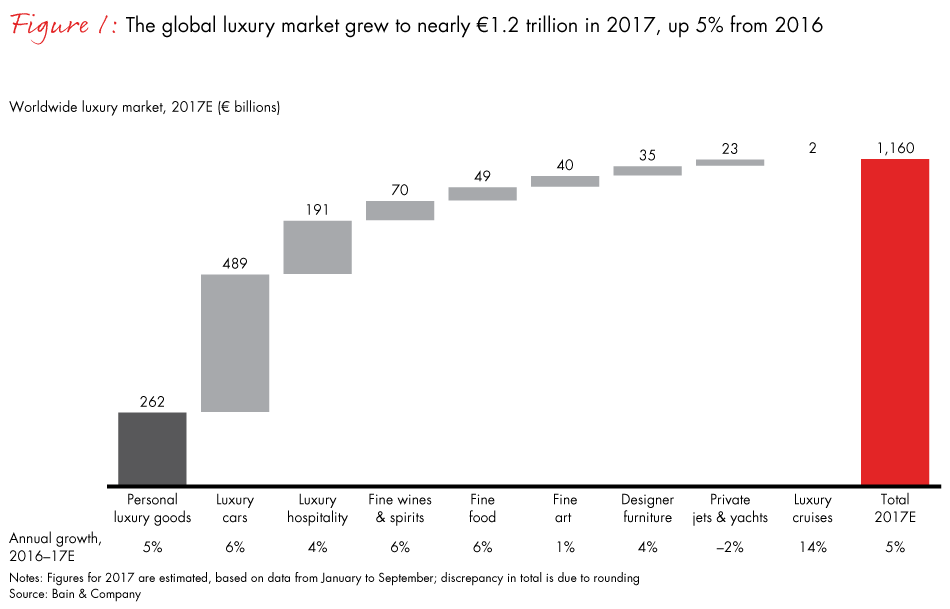
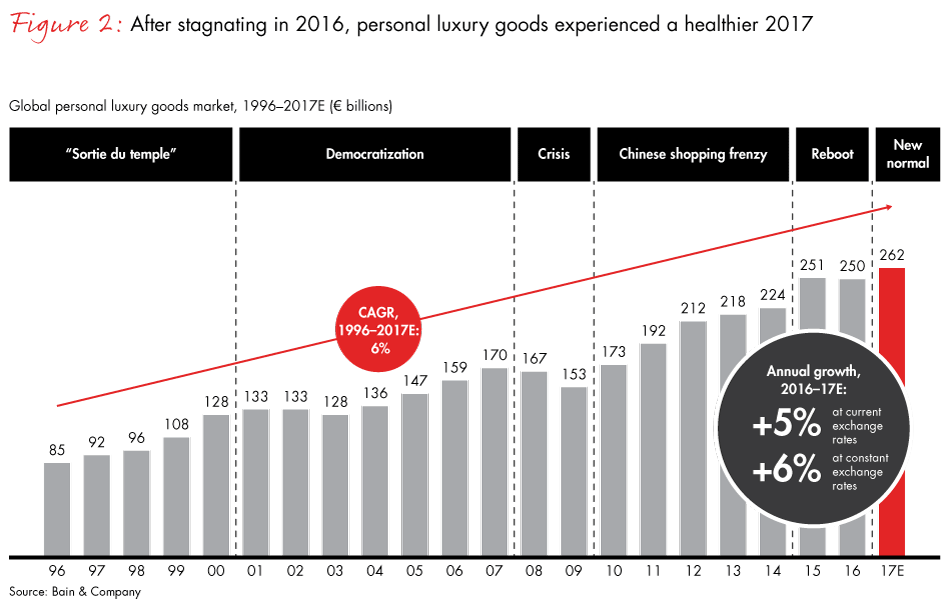
2. Regional highlights
- The personal luxury goods market posted positive growth across all key regions. More robust local consumption (up 4%) and strong tourist purchases (up 6%) contributed to the strong performance.
- Chinese consumption bounced back in 2017, fueled by renewed consumer confidence and the rapid emergence of a new middle class. Sales in mainland China grew by a remarkable 15% at current exchange rates, to a total market size of €20 billion. Buying abroad also increased. Globally, the share of personal luxury goods purchased by Chinese nationals reached 32%.
- A currency-driven boost in the second half of the year, along with increased Chinese spending, propelled Japan to 4% growth in personal luxury goods spending, at current exchange rates, to €22 billion.
- The rest of Asia (excluding mainland China and Japan) also had a strong showing, with sales increasing by 6% at current exchange rates. A recovery in Hong Kong and Macau helped push growth into positive territory, with the market for personal luxury goods reaching €36 billion.
- Europe continued to bounce back, growing by 6% at current exchange rates and reaching €87 billion in retail sales to regain its place as the top region for luxury sales by value. Tourist flows continued to support the market in the UK, Spain and France, and local consumption strengthened as well, particularly in Germany.
- The American market (including both North and South America) has struggled but still managed to finish the year in positive territory, growing by 2%. At €84 billion, it remains a crucial market for luxury brands, despite the challenging environment for department stores Canada and Mexico were among the bright spots in the region.
- In other regions, growth was flat at 1%, with the Middle East restrained by economic uncertainty.
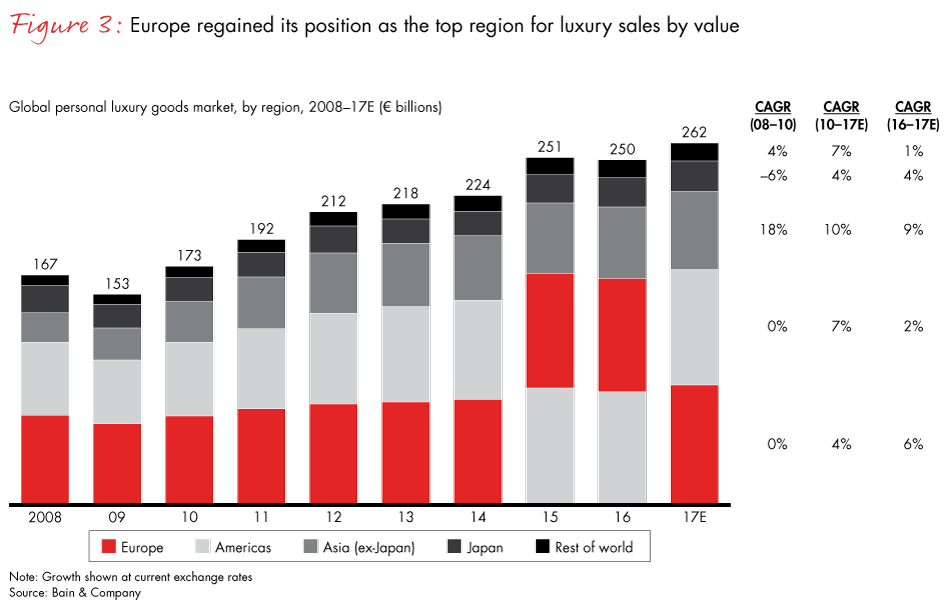

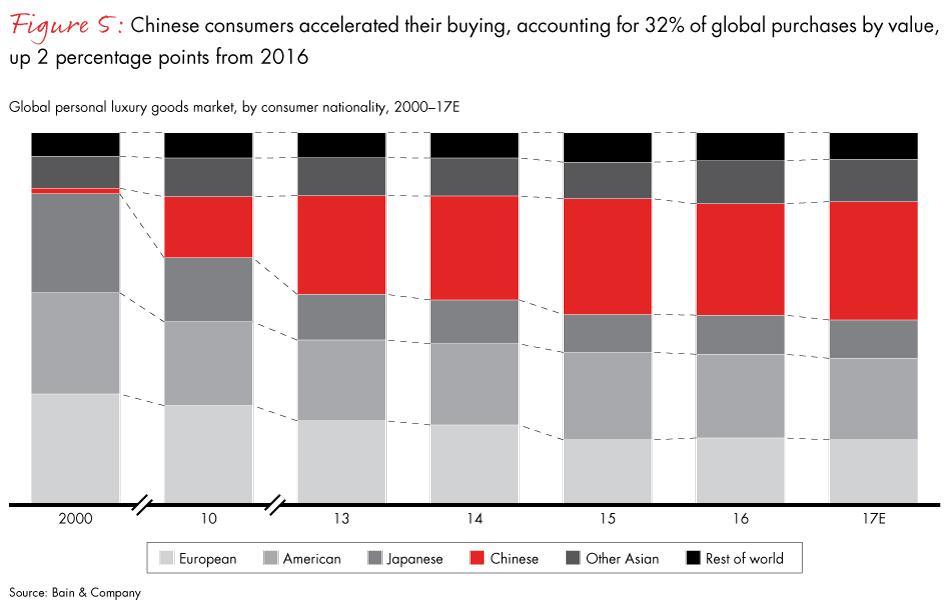
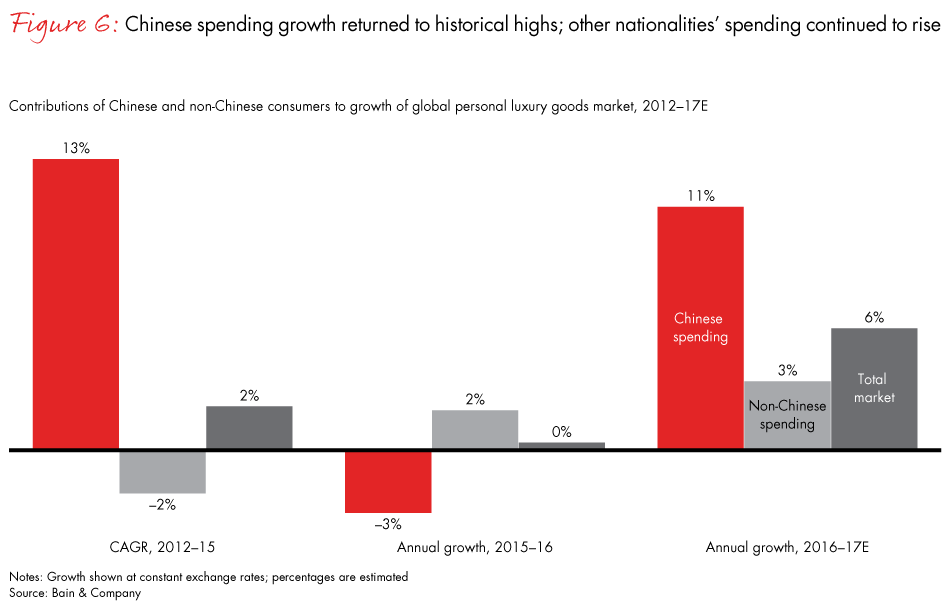

3. Distribution trends
- Wholesale remains the largest channel for luxury goods, accounting for roughly two-thirds of all sales. Yet the retail channel continued growing steadily—rising 8% in 2017 alone—as companies increasingly seek to control the experience they deliver to customers. Of that gain, 3% came from new-store openings and the remaining 5% came from same-store sales growth. Wholesale grew by only 3%, as the strong performance of specialty stores was partially offset by the disappointing performance of department stores globally.
- Off-price stores and airport stores showed strong growth (up 8% and 12%, respectively).
- Online sales continued their relentless climb, increasing by 24%. The Americas market makes up close to half of global online luxury sales—which total €23 billion—but growth was particularly strong in Europe and Asia. Accessories (including handbags and shoes) remained the top category sold online, ahead of apparel. Beauty and hard luxury (jewelry and watches) were both on the rise. Brands are finally starting to be proactive about making their mark in this channel by establishing their own websites, which now account for 31% of sales. But specialized luxury e-tailers still earn the lion's share of online sales.

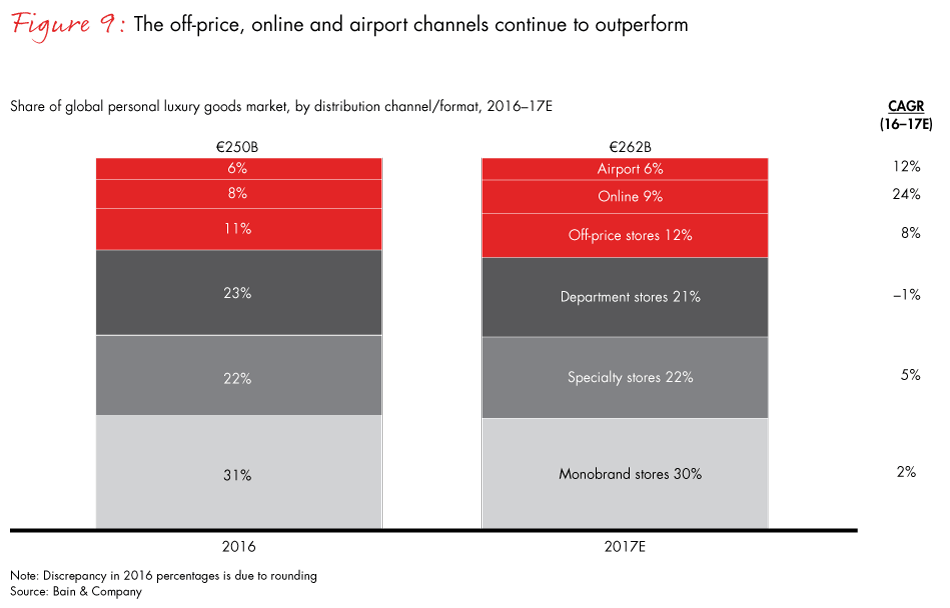
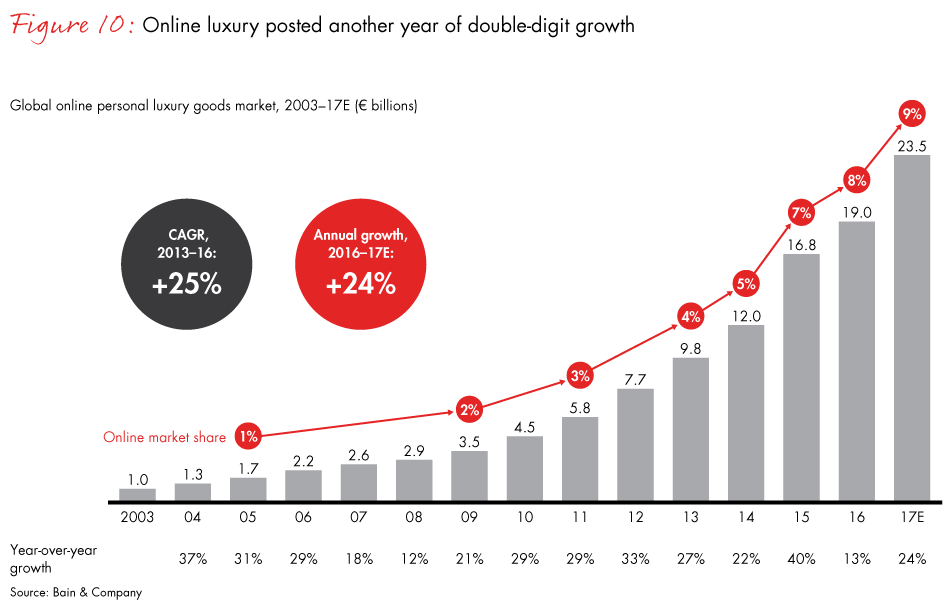

4. Customer shifts and individual category performance
- The main growth engine of the luxury market is a generational shift, with 85% of luxury growth in 2017 fueled by Generations Y and Z. But a broader "millennial state of mind" is permeating the luxury industry and changing the ways in which all generations make purchases. This shift also pushes luxury brands to redefine what they deliver to customers, and how they deliver it.
- Shoes, jewelry and handbags ranked as the three fastest-growing product categories, increasing by 10%, 10% and 7%, respectively, at current exchange rates. Apparel, beauty and handbags still make up the bulk of global luxury purchases, amounting to €61 billion, €54 billion and €48 billion, respectively—and collectively representing 62% of the personal luxury goods market.
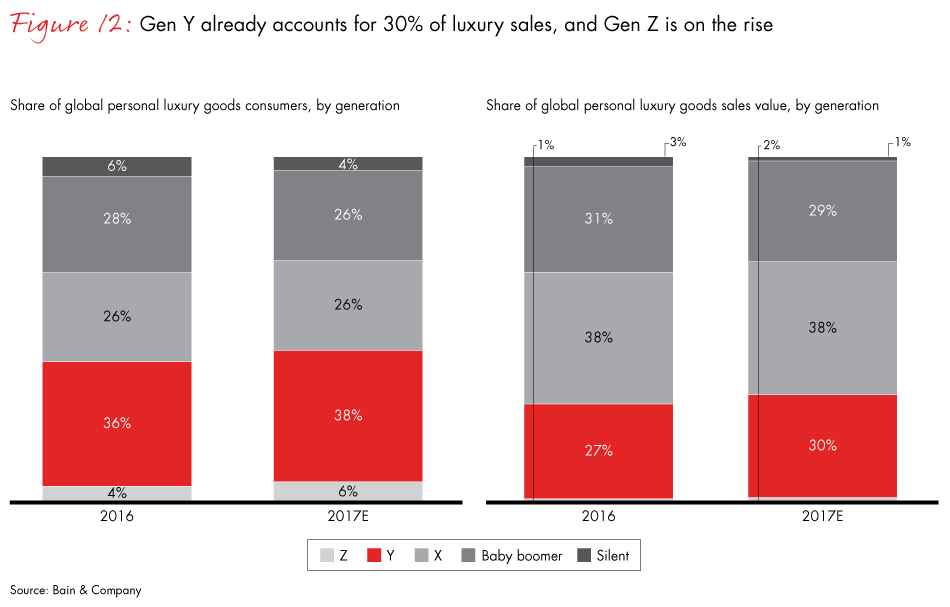
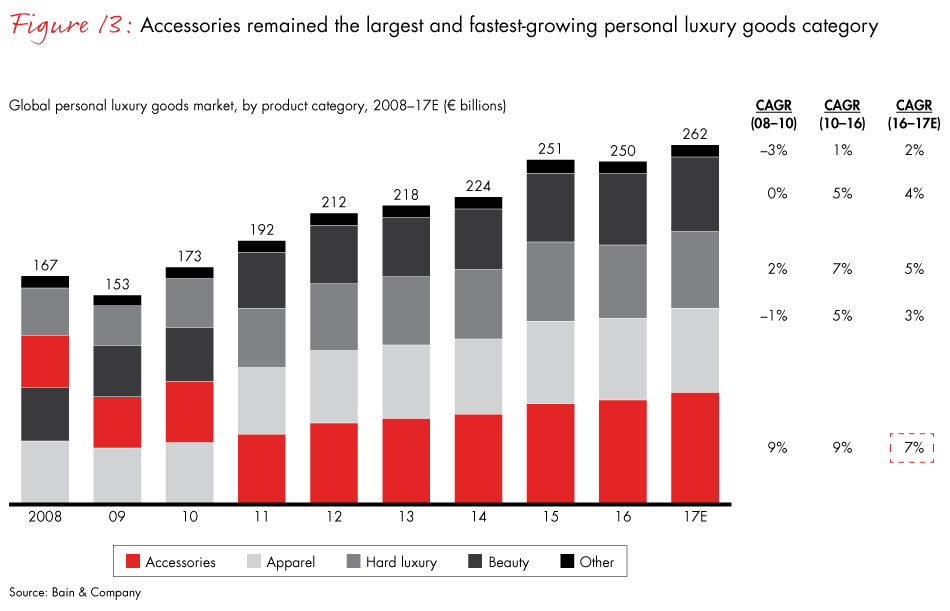
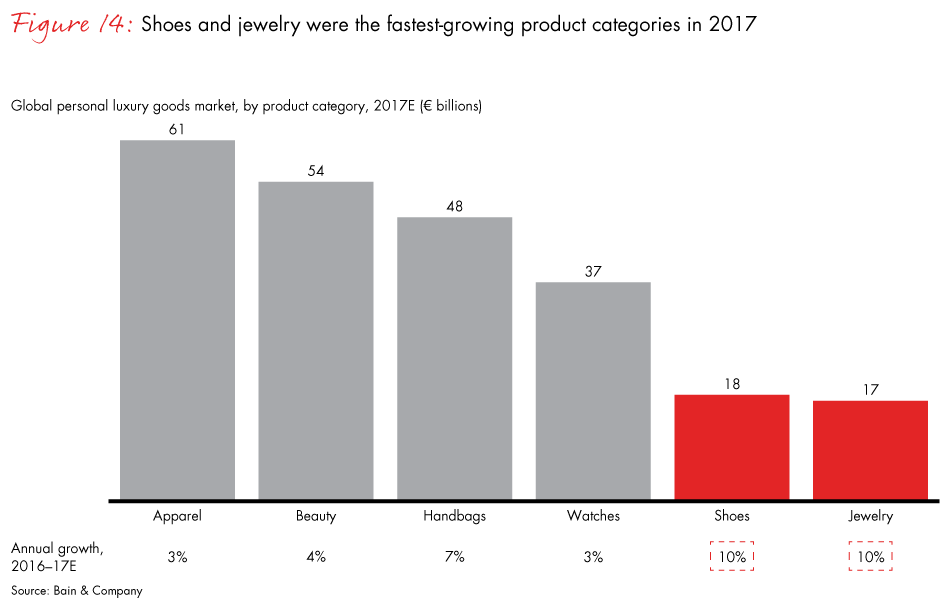
5. Outlook for the future
- We expect growth to continue at an estimated 4%–5% compound annual rate over the next three years (at constant exchange rates), with the market for personal luxury goods reaching €295–€305 billion by 2020.
- Over the next decade, the luxury market's distribution footprint is likely to evolve significantly. Although Bain estimates that physical stores will still account for 75% of purchases, the mix of store formats will shift away from monobrand stores, department stores and specialty stores, toward off-price stores and airport stores. In addition, we estimate that online sales for personal luxury goods will make up 25% of the market by 2025.
- Overall market conditions shifted in a positive direction in 2017. Nearly two-thirds of all luxury brands (65%) experienced growth, up from only 50% in 2016.
- However, long-term performance hurdles remain high, given a clear polarization between winners and losers. Over the period from 2014 to 2017, among the 65% of brands that managed to grow revenue, only one-third were also able to grow their profits.




Appendix
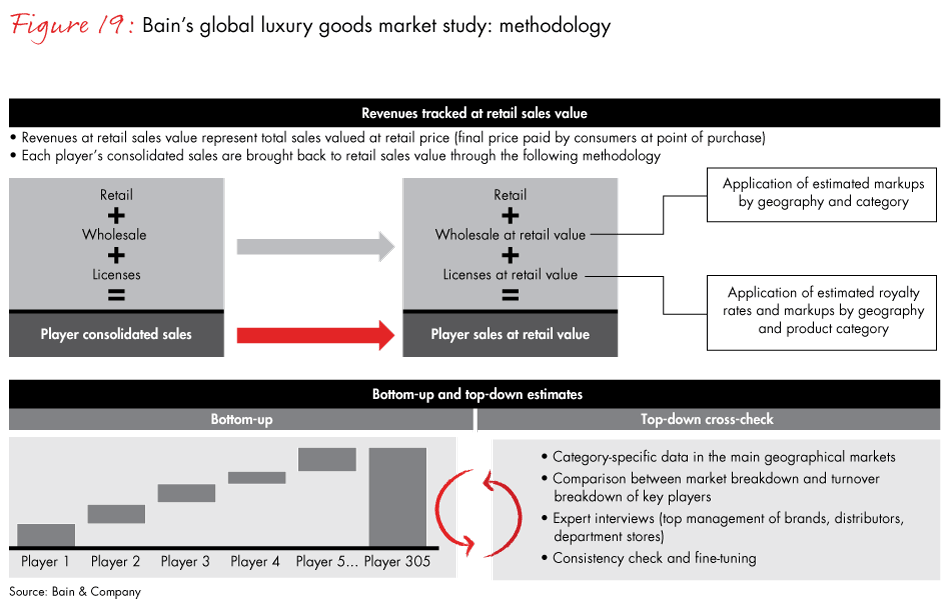
Claudia D'Arpizio and Federica Levato are Bain & Company partners based in the firm's Milan office. Marc-André Kamel is a Bain partner in Paris, and he leads the firm's Retail and Luxury practices in Europe, the Middle East and Africa. Joëlle de Montgolfier, also based in the Paris office, is the practice area senior director for Retail, Luxury and Consumer Products in EMEA. All four are leading members of Bain’s Global Retail and Luxury practices.